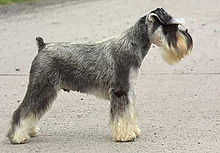Miniature Schnauzer

Classic pose of a Miniature Schnauzer. This dog has a natural (stripped) salt and pepper coat, natural ears and docked tail.
|
|||||||||||||||||||||||||||||||||
| Other names | Zwergschnauzer (Dwarf Schnauzer) | ||||||||||||||||||||||||||||||||
|---|---|---|---|---|---|---|---|---|---|---|---|---|---|---|---|---|---|---|---|---|---|---|---|---|---|---|---|---|---|---|---|---|---|
| Origin | Germany | ||||||||||||||||||||||||||||||||
|
|||||||||||||||||||||||||||||||||
|
|||||||||||||||||||||||||||||||||
| Domestic dog (Canis lupus familiaris) | |||||||||||||||||||||||||||||||||
| Traits | |||
|---|---|---|---|
| Weight | Male | 11 to 18 lb (5.0 to 8.2 kg) |
|
| Female | 10 to 15 lb (4.5 to 6.8 kg) |
||
| Height | Male | 14 in (35.6 cm) | |
| Female | 13 in (33.0 cm) | ||
| Coat | Harsh and wiry when hand stripped, soft and curly when unclipped | ||
| Color | Black, salt-and-pepper, black-and-silver, white | ||
| Litter size | 3 to 8 pups | ||
| Life span | 12 to 14 years | ||
| Classification / standards | |||
|---|---|---|---|
| FCI | Group 2, Section 1.2 Schnauzer #183 | standard | |
| AKC | Terrier | standard | |
| ANKC | Group 6 - Utility | standard | |
| CKC | Group 4 - Terriers | standard | |
| KC (UK) | Utility | standard | |
| NZKC | Utility | standard | |
| UKC | Terrier | standard | |
The Miniature Schnauzer is a breed of small dog of the Schnauzer type that originated in Germany in the mid-to-late 19th century. Miniature Schnauzers developed from crosses between the Standard Schnauzer and one or more smaller breeds such as the Poodle and Affenpinscher, as farmers bred a small dog that was an efficient ratting dog. They are described as "spunky" but aloof dogs, with good guarding tendencies without some guard dogs' predisposition to bite. Miniature Schnauzers are recognized in three colors internationally: solid black, black and silver, and a color known as 'salt and pepper'. There is a controversial fourth color variant in Miniature Schnauzers, pure white, which is not recognized universally.
The breed remains one of the most popular worldwide, primarily for its temperament and relatively small size. As of 2013 it is the 17th most popular breed in the U.S.
The earliest records surrounding development of the Standard Schnauzer in Germany come from the late 19th century. They were originally bred to be medium-sized farm dogs in Germany, equally suited to ratting, herding, and guarding property. As time passed, farmers bred the Standard Schnauzer into a smaller, more compact size for ratting by combining it with the Affenpinscher and Miniature Poodle. The first recorded Miniature Schnauzer appeared in 1888, and the first exhibition was held in 1899.
The AKC accepted registration of the new breed in 1926, two years after Miniature Schnauzers were introduced to the United States. They were originally known as Wirehaired Pinschers. International Kennel Club classifications vary; in the United Kingdom and Australia they fall within the Utility Group, while in Canada they are in the Working Group. In the AKC the Miniature Schnauzer is classed with the terriers. It was recognized by the United Kennel Club in 1948 and also classed as a terrier. The start of the modern Miniature Schnauzer is generally considered to begin with Ch. Dorem Display, the first Miniature Schnauzer to win Best in Show at the Westminster Kennel Club Dog Show. He was born 5 April 1945 and lived to be nearly fourteen. Almost every living Miniature Schnauzer in America can trace its lineage back to Dorem Display.
...
Wikipedia
